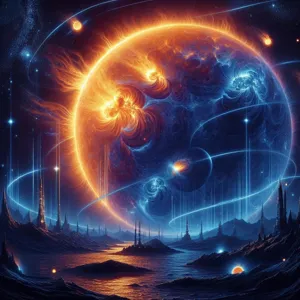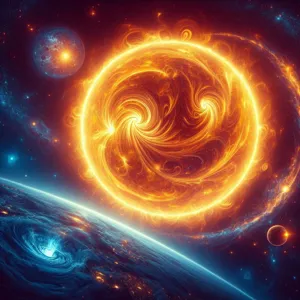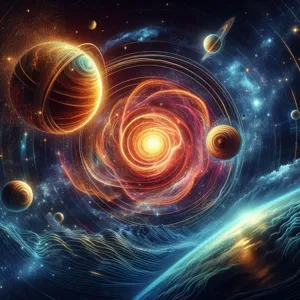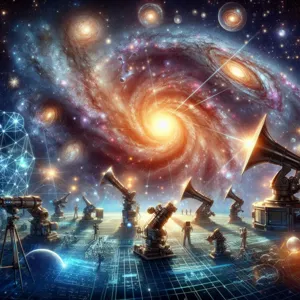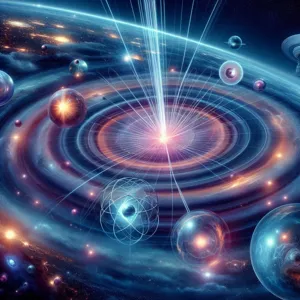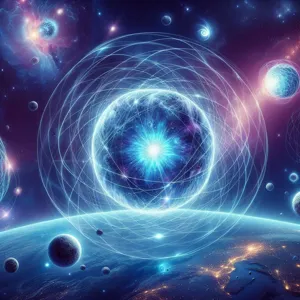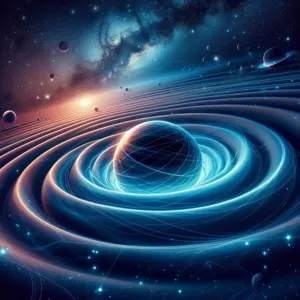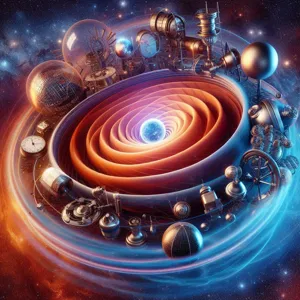The cosmos, with its vast expanse of stars, planets, and mysterious phenomena, has long captivated the human imagination.
Yet, beyond the glittering facade lies a complex interplay of forces that govern the behavior of celestial bodies. Among these, planetary magnetic fields play a crucial role in shaping the environments of planets and their potential to harbor life. In this blog post, we will embark on a fascinating journey into the world of astronomy, exploring the innovative techniques and cutting-edge technologies that astronomers employ to study these enigmatic fields. From the use of spacecraft equipped with sophisticated instruments to the analysis of data from telescopes, we will uncover the methods that allow scientists to unveil the secrets of planetary magnetic fields. Join us as we delve into the magnetic dance of planets, revealing how these invisible forces influence everything from atmospheric dynamics to space weather, while also igniting our curiosity about the universe beyond our own planet.
1. Introduction to Planetary Magnetic Fields

Planetary magnetic fields are an intriguing aspect of astrophysics, serving as both guardians and storytellers of the celestial bodies they envelop. These magnetic shields, generated by the motion of conductive fluids within a planet’s core, play a vital role in protecting atmospheres from the relentless solar wind and cosmic radiation. They can influence everything from atmospheric retention to the potential for life itself, making their study essential for understanding not just planets, but the very nature of our solar system and beyond.
In our quest to unveil the cosmos, astronomers meticulously examine the magnetic fields of various planets, including Earth, Mars, Jupiter, and Saturn. Each body presents a unique magnetic character—Earth’s dynamic field is constantly shifting and evolving, while Mars has a patchy magnetic field that hints at its once vibrant atmosphere. Jupiter, on the other hand, boasts the strongest magnetic field among the planets, an intricate tapestry woven from its rapid rotation and fluid metallic hydrogen core.
To study these magnetic fields, astronomers rely on a combination of spacecraft missions, ground-based observations, and advanced computer modeling. Instruments like magnetometers, which measure the strength and direction of magnetic fields, are crucial in gathering data from orbiters and landers. This information not only enhances our understanding of individual planets but also contributes to broader theories about magnetic field dynamics across the universe.
As we embark on this journey through the intricate dance of planetary magnetic fields, we will explore the techniques employed by astronomers, the significance of their findings, and how these invisible forces shape the environments and histories of the worlds we endeavor to understand. Join us as we delve deeper into the magnetic mysteries of our solar system and beyond, revealing the hidden connections that govern the cosmos.
2. The Importance of Magnetic Fields in Astronomy
Magnetic fields play a crucial role in the field of astronomy, acting as invisible architects that shape the environments of planets, stars, and galaxies. By studying these magnetic fields, astronomers gain insights into the fundamental processes that govern celestial bodies and their interactions with the cosmos.
At the heart of this importance lies the protective shield that magnetic fields provide. For planets like Earth, the magnetic field acts as a barrier against harmful solar winds and cosmic radiation, preserving the atmosphere and enabling life to thrive. This protective effect is also observed in other planets, such as Jupiter and Saturn, where their robust magnetic fields help to maintain their thick atmospheres and complex weather systems. Understanding these magnetic shields not only aids in the study of planetary habitability but also sheds light on the evolutionary history of our solar system.
Additionally, magnetic fields are integral to the formation and evolution of stars. As interstellar gas and dust collapse under gravity to form new stars, the magnetic fields present in these regions influence the flow of material, guiding the process of star formation. By analyzing the alignment and strength of these fields, astronomers can infer details about the physical conditions in molecular clouds and the lifecycle of stellar objects.
Magnetic fields also play a significant role in the dynamics of galaxies. They can influence star formation rates and the distribution of cosmic rays, impacting the overall structure and behavior of galaxies over time. By studying the magnetic fields in galaxies, astronomers can piece together the galactic evolution story and the interplay between magnetic forces and gravitational dynamics.
Through techniques such as magnetometry, radio observations, and computer simulations, astronomers are constantly uncovering the mysteries of magnetic fields across the universe. The study of these fields not only enhances our understanding of individual celestial objects but also offers a broader perspective on the intricate web of forces that govern the cosmos. In essence, magnetic fields are not just an abstract concept; they are fundamental players in the cosmic drama, influencing everything from the birth of stars to the stability of entire galaxies.
3. Basic Principles of Magnetism in Space

To grasp how astronomers study planetary magnetic fields, it’s essential to first understand the basic principles of magnetism in space. Magnetism, a fundamental force of nature, arises from the movement of charged particles. In the vast expanse of the cosmos, magnetic fields are generated by celestial bodies, including planets, stars, and galaxies, through intricate processes that occur deep within their interiors.
At the heart of this phenomenon lies the motion of conductive fluids—such as the molten iron in a planet’s core—which can generate magnetic fields through a process known as the dynamo effect. As these fluids circulate, they create electric currents, which in turn produce magnetic fields. This interplay is not just confined to Earth; giant planets like Jupiter and Saturn also exhibit powerful magnetic fields, significantly influencing their environments and interactions with solar winds.
Understanding magnetism in space requires recognizing its relationship with gravity and electric fields. While gravity pulls matter together, magnetism can push and pull charged particles in various directions, leading to complex dynamics. For instance, when solar wind—a stream of charged particles from the sun—interacts with a planet’s magnetic field, it can lead to phenomena such as auroras and magnetic storms.
Astronomers utilize a variety of tools and techniques to study these magnetic fields, including spacecraft equipped with magnetometers that measure the strength and direction of magnetic fields in real-time. By analyzing the data collected from these instruments, scientists can infer the internal structures of planets, their evolutionary histories, and their potential for sustaining life. Through this lens, the study of planetary magnetic fields not only unveils the hidden dynamics of our solar system but also enhances our understanding of the universe as a whole.
4. Historical Discoveries in Planetary Magnetism
The study of planetary magnetic fields has a rich history, marked by groundbreaking discoveries that have shaped our understanding of the cosmos. In the mid-20th century, the dawn of the space age opened new frontiers in astronomy, allowing scientists to explore celestial bodies beyond Earth. One of the pivotal moments came with the launch of NASA’s Mariner 10 spacecraft in 1974, which became the first to study Mercury up close. Mariner 10 revealed that Mercury, despite its small size and proximity to the Sun, possesses a significant magnetic field—about 1% the strength of Earth’s. This unexpected finding challenged existing theories and prompted further investigation into the planet’s core and composition.
Following in the footsteps of Mariner 10, the Voyager missions in the late 1970s provided groundbreaking data on the magnetic fields of Jupiter and Saturn. Voyager 1 and 2 not only confirmed that these gas giants possess complex magnetic environments but also offered insights into their intricate magnetospheres. The discoveries of Jupiter’s powerful magnetic field, which is 20,000 times stronger than Earth’s, and Saturn’s unique magnetic structure, shaped by its rapid rotation and dynamic atmosphere, revolutionized our understanding of planetary magnetism.
The historical significance of these missions cannot be overstated. Each discovery added a piece to the puzzle of how planetary bodies generate and maintain magnetic fields. The study of magnetic fields has also illuminated the protective role these fields play against solar and cosmic radiation, which is crucial for understanding the habitability of other worlds.
As astronomers continue to analyze data from newer missions, such as ESA’s BepiColombo, which is set to explore Mercury further, and the upcoming Mars Sample Return mission, the rich history of planetary magnetism serves as a foundation for future discoveries. Each finding not only enhances our knowledge of specific planets but also invites us to ponder the broader implications of magnetic fields in the universe, including their role in the formation and evolution of planetary systems.
5. Techniques for Measuring Magnetic Fields

Measuring the magnetic fields of celestial bodies is a complex yet fascinating endeavor that utilizes a variety of innovative techniques. Astronomers employ a combination of direct and indirect methods to accurately gauge these invisible forces, revealing crucial information about the planets’ internal structures and their interactions with solar winds.
One of the primary techniques is **magnetometry**, which involves using sensitive instruments known as magnetometers. These devices can be mounted on satellites and spacecraft, allowing them to measure magnetic fields from a distance. By analyzing variations in the magnetic field strength as the spacecraft orbits a planet, scientists can construct a detailed map of the planetary magnetic field. For example, NASA’s MAVEN mission has provided invaluable data on Mars’ magnetic field, shedding light on the planet’s atmospheric loss over billions of years.
Another method involves **remote sensing**, where astronomers observe the interaction of a planet’s magnetic field with charged particles from the solar wind. This can be achieved through instruments that detect radio emissions or plasma waves generated as solar particles collide with the planet’s magnetic field. Such observations can provide insights into the magnetic field’s strength and orientation, as well as its dynamic behavior.
For planets with a significant atmosphere, **magnetotellurics** can be employed. This technique measures the Earth’s natural electromagnetic fields at different depths to infer subsurface conductivity and, in turn, the presence of magnetic materials. By extending this technique to other planetary bodies, researchers can gain insights into their geological history and the composition of their interiors.
Lastly, **computer modeling** plays a crucial role in understanding planetary magnetic fields. By simulating the behavior of magnetic fields based on observational data, scientists can predict how these fields evolve over time and how they interact with the solar environment. This approach is particularly useful for understanding the magnetic dynamics of distant exoplanets where direct measurement is not feasible.
Through these advanced techniques, astronomers continue to unveil the complex interplay between planetary bodies and their magnetic fields, revealing insights that not only enhance our understanding of individual planets but also contribute to the broader knowledge of planetary formation and evolution in our universe.
6. Space Missions and Their Contributions
Space missions have played a pivotal role in advancing our understanding of planetary magnetic fields, offering unprecedented insights that ground-based observations simply cannot provide. These ventures into the cosmos have equipped astronomers with cutting-edge technology and instruments designed to measure magnetic fields with incredible precision. From orbiters to landers, each mission has contributed valuable data to the broader understanding of how magnetic fields shape planetary atmospheres, shield against solar winds, and even influence the potential for habitability.
One of the most notable missions is NASA’s MAVEN (Mars Atmosphere and Volatile EvolutioN) spacecraft, launched in 2013. MAVEN has been instrumental in studying the Martian atmosphere and its interaction with solar wind, revealing how the planet’s weak magnetic field allows charged particles to strip away its atmosphere over time. This has crucial implications for understanding Mars’ climate history and the potential for past life.
Similarly, the Juno mission, currently orbiting Jupiter, has provided groundbreaking information about the gas giant’s magnetic field. Juno’s sophisticated magnetometer has allowed scientists to map Jupiter’s magnetic environment in detail, revealing its complex and dynamic nature. The mission has also shed light on the planet’s interior structure, suggesting that its magnetic field is influenced by processes deep within its atmosphere.
Moreover, missions like ESA’s BepiColombo, aimed at exploring Mercury, are set to enrich our understanding of magnetic fields even further. By studying Mercury’s magnetic field, which is unique due to its small size and large iron core, astronomers hope to uncover the mysteries of how a planet can maintain a magnetic field without the size of larger celestial bodies.
Each of these missions not only contributes crucial data but also inspires new questions and theories about the formation and evolution of planetary systems. As technology continues to advance, future missions will undoubtedly unlock even more secrets of the cosmos, providing deeper insights into the magnetic forces that govern the behavior of planets and potentially guiding us toward new discoveries about the universe’s intricate tapestry.
7. Case Study: Earth’s Magnetic Field

Earth’s magnetic field serves as a fascinating case study for astronomers and geophysicists alike, offering invaluable insights into the dynamics of planetary magnetic fields. Stretching from the planet’s core out into space, this magnetic field is generated by the movement of molten iron and nickel in the outer core, creating a geodynamo effect. What makes Earth’s magnetic field particularly intriguing is its complexity and the way it interacts with solar winds — streams of charged particles emitted by the sun.
To study this magnetic field, scientists employ a variety of methods, from ground-based magnetometers to satellite missions like the European Space Agency’s Swarm mission, which is designed to measure the strength and structure of Earth’s magnetic field with unprecedented precision. These satellites provide a three-dimensional view of the magnetic field, allowing researchers to analyze its variations over time and space. By tracking changes in the magnetic field, scientists can glean information about tectonic activities, ocean currents, and even space weather phenomena.
One of the most critical aspects of Earth’s magnetic field is its role in protecting the planet from cosmic radiation and solar flares. The field acts as a shield, deflecting charged particles from the sun and preventing them from stripping away the atmosphere, a fate that has befallen planets like Mars. This protective barrier is vital for sustaining life on Earth, as it maintains the atmospheric conditions necessary for hydration and temperature regulation.
Moreover, Earth’s magnetic field is not static; it undergoes periodic reversals where the magnetic poles switch places. This phenomenon, known as geomagnetic reversal, occurs over thousands to millions of years and has been documented in the geological record. Understanding the mechanisms behind these reversals is crucial for astronomers, as it provides insights into the thermal and dynamic processes occurring within the Earth’s core.
By examining Earth’s magnetic field, astronomers can not only enhance their understanding of our own planet but also draw parallels with other celestial bodies. For instance, comparing Earth’s magnetic field with those of Mars, Venus, and gas giants like Jupiter and Saturn helps scientists infer the conditions and processes that might be necessary for sustaining magnetic fields around other planets, which is key to understanding their potential habitability.
In summary, the study of Earth’s magnetic field is not merely an academic pursuit; it holds the key to understanding broader cosmic phenomena, the history of our planet, and the very fabric of life as we know it. As astronomers continue to unveil the mysteries of planetary magnetic fields, Earth remains a cornerstone case study, providing a rich tapestry of insights that resonate throughout the cosmos.
8. Exploring Magnetic Fields of Other Planets
Exploring the magnetic fields of other planets opens a fascinating window into the workings of our solar system and beyond. While Earth’s magnetic field is familiar to us, generated by the movement of molten iron in its outer core, the magnetic environments of other planets reveal diverse and intriguing phenomena.
Take Mars, for instance. Unlike Earth, Mars lacks a global magnetic field, but remnants of localized magnetic fields can be found in the ancient crust, hinting at a once-thriving magnetic dynamo. By studying these remnants, astronomers can glean insights into the planet’s geological history and its past habitability.
Jupiter, on the other hand, boasts the strongest magnetic field of any planet in our solar system, more than 20,000 times stronger than Earth’s. Its immense magnetic field is generated by the motion of metallic hydrogen deep within its atmosphere. This powerful magnetosphere not only influences the planet’s many moons but also creates spectacular auroras that dwarf those seen on Earth. Observations from spacecraft like the Juno probe have provided unprecedented data about Jupiter’s magnetic field structure and its interaction with solar wind, painting a vivid picture of the planet’s dynamic atmosphere.
Saturn, with its stunning rings and numerous moons, also has a compelling magnetic field. Studying Saturn’s magnetosphere reveals how its magnetic field interacts with its rings and the solar wind, creating a complex system of plasma and charged particles. Missions like Cassini have helped scientists understand how the intricate dance of magnetic fields shapes the environment around Saturn and its moons.
As astronomers continue to explore the magnetic fields of exoplanets—planets located outside our solar system—they face new challenges and opportunities. Advanced telescopes and detection techniques allow scientists to infer the presence of magnetic fields on distant worlds, offering clues about their atmospheres and potential habitability. Understanding these magnetic environments is crucial, as they can protect planets from cosmic radiation and contribute to the development of life.
Ultimately, the exploration of planetary magnetic fields not only enhances our knowledge of individual planets but also enriches our understanding of planetary formation, evolution, and the broader dynamics of celestial bodies. Each discovery adds a piece to the cosmic puzzle, illuminating the profound and intricate relationships between planets and their magnetic environments.
9. The Role of Magnetometry in Planetary Science
Magnetometry serves as a cornerstone in the study of planetary magnetic fields, providing astronomers with critical insights into the composition, structure, and dynamics of celestial bodies. Utilizing sophisticated instruments designed to measure magnetic fields, researchers can discern the strength and orientation of a planet’s magnetosphere. This technique is particularly vital when examining bodies without a significant atmosphere, such as the Moon or various asteroids, where magnetic data can reveal the remnants of ancient magnetic activity or tectonic processes.
Through magnetometry, scientists employ both ground-based and spaceborne magnetometers to gather data, often during flybys or orbital missions. For instance, the MAVEN mission studying Mars has equipped the spacecraft with a magnetometer that allows for the remote sensing of the planet’s magnetic environment, revealing much about its atmospheric loss and potential habitability. By analyzing variations in magnetic field strength, researchers can infer the presence of iron-rich cores and understand the geological history of these planets.
Moreover, magnetometry helps to differentiate between various types of magnetic materials present on the planetary surface, shedding light on the internal structure and formation processes of these celestial bodies. The insights gained from magnetometric studies not only enhance our understanding of individual planets but also contribute to broader theories about the evolution of the solar system and the magnetic phenomena that govern it. In essence, magnetometry acts as a powerful lens through which the hidden complexities of planetary systems are revealed, unlocking the secrets of the cosmos one magnetic field at a time.
10. Data Analysis Techniques for Magnetic Field Studies
When it comes to unraveling the mysteries of planetary magnetic fields, data analysis plays a pivotal role in transforming raw measurements into meaningful insights. Astronomers utilize a diverse array of data analysis techniques to interpret magnetometric data collected from spacecraft and ground-based observations, enabling them to construct a comprehensive picture of a planet’s magnetic environment.
One of the fundamental techniques employed is **spectral analysis**, which allows researchers to identify the frequency components of magnetic signals. By examining the oscillations within the magnetic field, astronomers can infer the dynamics of the planet’s interior and its interaction with solar wind. This technique is particularly useful for understanding variations in magnetic intensity and direction over time, revealing patterns that hint at the underlying processes at play.
**Statistical modeling** also plays a crucial role in analyzing magnetic field data. By applying sophisticated statistical methods, astronomers can discern significant anomalies from background noise, isolating features of interest. For instance, they may utilize regression analysis to correlate magnetic field measurements with other planetary data, such as atmospheric composition or geological structures, thereby uncovering relationships that deepen our understanding of planetary evolution.
Moreover, **computer simulations** are invaluable in this process. By creating models that simulate the magnetic field dynamics based on known physical laws, astronomers can compare simulated data with actual measurements. This iterative approach helps refine models of a planet’s core dynamics, magnetic generation processes, and even its historical magnetic field reversals.
Lastly, **machine learning algorithms** are increasingly being integrated into data analysis workflows. These advanced computational techniques can sift through vast datasets, identifying hidden patterns that may elude traditional analysis methods. By training algorithms on existing magnetic field data, astronomers can enhance their predictive capabilities, allowing for more accurate models of planetary magnetism.
Through these varied data analysis techniques, astronomers are not only deciphering the intricate dance of planetary magnetic fields but are also piecing together the broader narrative of how these celestial bodies interact with their environments, ultimately shedding light on the complex tapestry of our cosmos.
11. Challenges in Studying Planetary Magnetic Fields
Studying planetary magnetic fields presents a unique set of challenges that can often feel like navigating a cosmic labyrinth. Unlike studying terrestrial magnetic fields, which we can observe directly and measure with relative ease, planetary magnetic fields are often shrouded in mystery and distance. One of the primary hurdles astronomers face is the sheer vastness of space. Many planets, especially those outside our solar system, are located light-years away, making direct measurements impractical. Instead, scientists rely on remote sensing techniques, which can yield limited information about a planet’s magnetic properties.
Additionally, the environments of other planets can be incredibly hostile. For instance, the extreme temperatures, radiation levels, and atmospheric conditions on gas giants like Jupiter or Saturn complicate measurements and often require sophisticated spacecraft equipped with specialized instruments. These instruments must be able to withstand harsh conditions while accurately capturing data on magnetic fields that are often weak and fluctuating.
Another obstacle is the need for detailed models to interpret the data gathered from these distant worlds. Without a solid understanding of a planet’s internal structure and composition, it can be difficult to draw accurate conclusions about its magnetic field. For example, understanding how the core dynamics of a planet contribute to its magnetic field is crucial, yet this knowledge is often based on theoretical models rather than direct observation.
Moreover, the interactions between a planet’s magnetic field and its atmosphere or solar wind add layers of complexity. For instance, how does a planet’s magnetic field protect its atmosphere from solar radiation, and what implications does this have for potential habitability? These questions require interdisciplinary collaboration among astronomers, physicists, and planetary scientists, further complicating the research process.
Despite these challenges, the quest to understand planetary magnetic fields is crucial, providing insights into a planet’s history, its potential for supporting life, and its interactions with the cosmos. As technology advances and our observational capabilities improve, astronomers remain undeterred, ready to tackle these obstacles head-on in their pursuit of cosmic knowledge.
12. The Impact of Magnetic Fields on Planetary Atmospheres
The interplay between magnetic fields and planetary atmospheres is a fascinating area of study that reveals a great deal about a planet’s ability to sustain life and its overall climatic conditions. Magnetic fields serve as protective shields, deflecting cosmic radiation and solar winds that could otherwise strip away a planet’s atmosphere over time. This phenomenon is particularly evident in our own solar system, where the presence—or absence—of a significant magnetic field can drastically influence atmospheric composition and stability.
For instance, consider Mars, a planet once believed to have harbored oceans and possibly life. Today, it exhibits a thin atmosphere composed mostly of carbon dioxide and experiences harsh surface conditions due in part to its weak magnetic field. Without a robust magnetic shield, solar winds have gradually eroded its atmosphere, leaving behind a planet that is dry and inhospitable. In contrast, Earth’s strong magnetic field, generated by its molten iron core, plays a crucial role in protecting our atmosphere, enabling it to support a diverse range of life forms.
Astronomers use a variety of tools to study these magnetic fields and their effects on planetary atmospheres. Space missions equipped with magnetometers measure magnetic field strength and direction, while spectrometers analyze atmospheric composition and behavior. Combined with data gathered from telescopes and satellites, these instruments help scientists piece together a planet’s magnetic history and its implications for atmospheric retention.
Understanding the interactions between magnetic fields and atmospheres is not only essential for comparative planetology but also for assessing the habitability of exoplanets beyond our solar system. As we continue to unveil the cosmos, insights gained from studying these magnetic phenomena will enhance our understanding of planetary environments and the potential for life beyond Earth.
13. Future Directions in Magnetic Field Research
As we venture deeper into the cosmos, the future of magnetic field research in planetary science holds exciting possibilities that promise to expand our understanding of both our solar system and beyond. One of the most significant directions in this field is the integration of advanced technology and multi-disciplinary approaches. With the advent of next-generation telescopes and sophisticated spacecraft equipped with high-precision magnetometers, astronomers will be able to gather unprecedented data on the magnetic fields of distant exoplanets and moons. These instruments will not only enhance our ability to measure magnetic strengths and orientations but also allow for the detection of subtle variations that can reveal a planet’s geological history and atmospheric dynamics.
Moreover, the development of computational models that simulate magnetic field interactions is set to revolutionize our analysis capabilities. By applying machine learning techniques to vast datasets, researchers will be able to identify patterns and correlations that were previously obscured by the sheer complexity of the data. This could lead to new insights into how magnetic fields interact with solar winds and cosmic radiation, ultimately influencing a planet’s habitability potential.
Collaborative efforts across international space agencies are also paving the way for ambitious missions aimed at studying magnetic fields in situ. For instance, missions like NASA’s Artemis program and the European Space Agency’s Jupiter Icy Moons Explorer (JUICE) are poised to explore the magnetic environments of the Moon and Jupiter’s moons, respectively. Such missions will provide groundbreaking opportunities to observe magnetic phenomena firsthand and deepen our understanding of the role magnetic fields play in shaping planetary atmospheres and surface conditions.
Lastly, the pursuit of knowledge in planetary magnetic fields is not just confined to our solar system. As astronomers set their sights on exoplanets orbiting distant stars, new techniques will emerge to infer magnetic field strengths from starlight interactions or the behavior of charged particles in the vicinity of these planets. This will significantly enhance our ability to assess the potential for life beyond Earth, as magnetic fields are crucial in shielding planetary atmospheres from harmful solar and cosmic radiation.
In summary, the future of magnetic field research is bright and full of potential. With advancing technologies, innovative methodologies, and collaborative missions, astronomers are on the brink of uncovering the secrets of magnetic fields across the universe. This ongoing exploration will not only deepen our understanding of planetary formation and evolution but also inform our quest to find life beyond our own planet.
14. The Role of Technology in Advancing Understanding
The exploration of planetary magnetic fields has significantly benefited from advancements in technology, revolutionizing how astronomers study the cosmos. Cutting-edge instruments and innovative techniques have opened new avenues for understanding the complex dynamics of magnetic fields on various celestial bodies.
One of the most impactful developments has been the enhancement of satellite missions equipped with sophisticated magnetometers. These instruments can measure the strength and direction of magnetic fields in space with unprecedented accuracy. For instance, missions like NASA’s MAVEN (Mars Atmosphere and Volatile EvolutioN) and ESA’s BepiColombo are specifically designed to explore the magnetic environments of Mars and Mercury, respectively. By collecting data from various altitudes and regions, these satellites provide invaluable insights into how planetary magnetic fields interact with solar winds and other cosmic phenomena.
Moreover, advancements in computational power and modeling techniques have allowed astronomers to simulate magnetic field behavior in real-time. High-performance computing enables researchers to create detailed models that can predict how magnetic fields evolve over time, offering a clearer understanding of their formation and influence on planetary atmospheres. This modeling is crucial for comparing theoretical predictions with observational data, thereby refining our understanding of magnetic processes.
In addition, ground-based observatories and radio telescopes have become instrumental in detecting and analyzing the electromagnetic emissions from planets, aiding in the study of their magnetic properties. Techniques such as Very Long Baseline Interferometry (VLBI) allow astronomers to achieve remarkable precision in their measurements, resulting in a deeper comprehension of planetary magnetic fields’ intricacies.
As technology continues to evolve, the potential for discoveries in the realm of planetary magnetic fields grows exponentially. Innovations such as artificial intelligence and machine learning are gradually being integrated into data analysis, enabling astronomers to identify patterns and correlations that were previously undetectable. With each technological leap, we move closer to unraveling the mysteries of how magnetic fields shape not just individual planets, but also the solar system as a whole, and ultimately, the universe.
15. Conclusion: The Broader Implications of Studying Magnetic Fields
In conclusion, the study of planetary magnetic fields extends far beyond the realms of astronomy and astrophysics; it is a gateway to understanding the very fabric of our universe and the dynamics of planetary systems. As we unveil the complexities of magnetic fields, we gain insight into the processes that shape not only the planets within our solar system but also those orbiting distant stars in far-off galaxies.
The implications of this research are profound. For instance, understanding a planet’s magnetic field helps us assess its potential habitability. A strong magnetic field can shield a planet from harmful solar radiation, preserving its atmosphere and, by extension, the possibility of life. This knowledge informs our search for extraterrestrial life and guides the selection of targets for future exploration missions.
Moreover, studying the magnetic fields of other planets can illuminate the history of our own Earth. By comparing different planetary magnetic environments, we gain insights into Earth’s geological processes and its evolutionary journey. These comparisons may help us predict future changes in our planet’s magnetic field, which can have significant implications for technology, climate, and even our daily lives.
Finally, the techniques and technologies developed to study magnetic fields can have broader applications beyond planetary science. Innovations in measurement and data analysis could lead to advancements in various fields, including space exploration, resource management, and environmental science.
As our tools and techniques continue to evolve, so too will our understanding of the cosmos. The study of planetary magnetic fields thus stands as a testament to humanity’s insatiable curiosity and our commitment to uncovering the mysteries of the universe. Through these efforts, we not only expand our knowledge of the cosmos but also reaffirm our connection to it, inspiring future generations to look up at the stars and ponder the possibilities that lie beyond our blue planet.
In conclusion, delving into the intricate tapestry of planetary magnetic fields not only enhances our understanding of individual celestial bodies but also unveils the broader mechanics of the universe. The methodologies employed by astronomers—ranging from advanced satellite observations to sophisticated modeling techniques—demonstrate the remarkable ingenuity of science in deciphering the cosmos. As we continue to explore these magnetic phenomena, we unlock secrets that can inform us about planetary formation, habitability, and even the history of our solar system. We hope this journey through the cosmos has ignited your curiosity and appreciation for the vast, magnetic wonders that exist beyond our Earth. Stay tuned for more explorations as we venture deeper into the mysteries of the universe!





